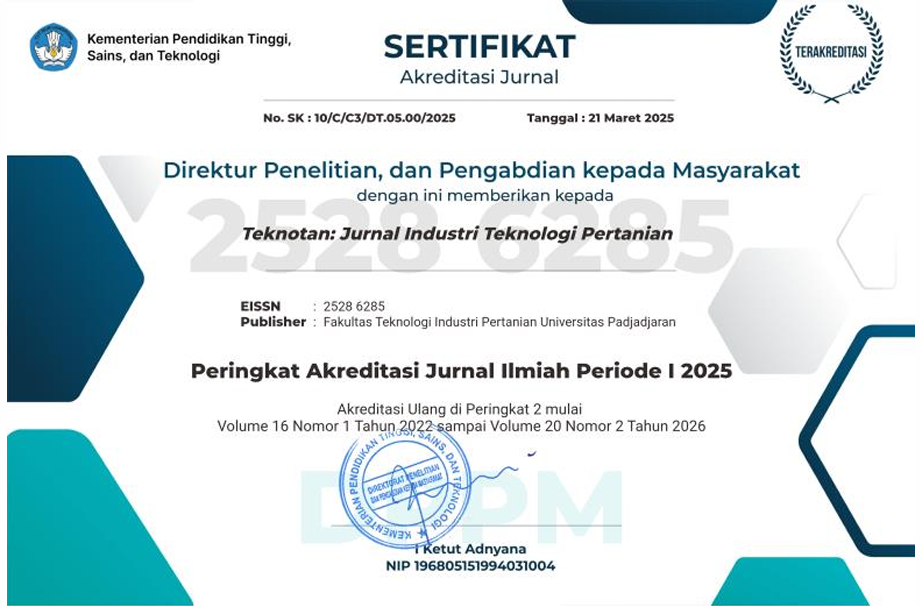Perubahan Sifat Fisik dan Hubungan Antar Parameter Nira Aren Selama Pemasakan Udara Terbuka
Abstract
Penentuan kondisi optimal proses pembuatan sirup aren cukup rumit karena terjadi perubahan mutu yang sangat cepat pada periode kritis dimana titik kritis sirup aren tercapai pada standar mutu nilai padatan terlarut sebesar 68-70 oBrix. Penelitian ini bertujuan untuk mengungkap hubungan antar parameter fisik nira aren selama proses pemasakan menjadi sirup aren. Massa aren yang digunakan untuk pemasakan 8,5 kg dengan kadar air 86,37% dan total padatan terlarut (TPT) 14 oBrix. Pemasakan ini menggunakan 3 zona meliputi fase pendidihan, fase penghilangan jumlah air volume besar dan zona pembentukan sirup. Energi pemasakan zona 1, 2 dan 3 secara berturut sebesar 9%, 78% dan 13%. Titik kritis pemasakan nira aren terjadi di zona 3 di fase pembentukan sirup yang dikonfirmasi dengan nilai indeks kecoklatan, TPT dan viskositas. Nilai atribut fisik sirup aren dengan pemasakan terbuka mencapai suhu akhir 102oC, waktu pemasakan 220 menit, kadar air 20%, TPT 70 oBrix, viskositas 750 mPas, L* 53,95, a* 5,27, b* 37,50, ΔE 5,9 dan chroma 37,59. Persamaan empiris antar parameter: TPT-kadar air y = -0,9143x + 90,57; TPT-viskositas y = 9.266ln(x) + 13.053; TPT-waktu pemasakan y = 16.821e-0.012x ; TPT-energi panas y = 10304ln(x) – 22715. Hasil penelitian ini menemukan bahwa ambang batas kritis sirup aren pada parameter TPT antara 68-70 oBrix dimana nilai TPT lebih dari 70 oBrix akan berpotensi pembentukan inti kristal yang dihindari dalam pembuatan sirup aren.
Keywords
Full Text:
PDF (Bahasa Indonesia)References
Abbès, F., Kchaou, W., Blecker, C., Ongena, M., Lognay, G., Attia, H., & Besbes, S. (2013). Effect of processing conditions on phenolic compounds and antioxidant properties of date syrup. Industrial Crops and Products, 44, 634–642. https://doi.org/10.1016/j.indcrop.2012.09.008
Adekunte, A. O., Tiwari, B. K., Cullen, P. J., Scannell, A. G. M., & O’Donnell, C. P. (2010). Effect of sonication on colour, ascorbic acid and yeast inactivation in tomato juice. Food Chemistry, 122(3), 500–507. https://doi.org/10.1016/j.foodchem.2010.01.026
Alarcón, Á. L., Orjuela, A., Narváez, P. C., & Camacho, E. C. (2020). Thermal and Rheological Properties of Juices and Syrups during Non-centrifugal Sugar Cane (Jaggery) Production. Food and Bioproducts Processing, 121, 76–90. https://doi.org/10.1016/j.fbp.2020.01.016
Apriyanti, D., & Fithriyah, N. H. (2013). Pengaruh Suhu Aplikasi Terhadap Viskositas Lem Rokok Dari Tepung Kentang. Konversi, 2(2), 23–34.
Asghar, M. T., Yusof, Y. A., Noriznan, M., & Yaacob, M. E. (2020). Original article Effect of processing method on vitamin profile , antioxidant properties and total phenolic content of coconut ( Cocos nucifera L .) sugar syrup. 2762–2770. https://doi.org/10.1111/ijfs.14529
Ben Thabet, I., Besbes, S., Masmoudi, M., Attia, H., Deroanne, C., & Blecker, C. (2009). Compositional, physical, antioxidant and sensory characteristics of novel syrup from date palm (Phoenix dactylifera L.). Food Science and Technology International, 15(6), 583–590. https://doi.org/10.1177/1082013209353079
Gabsi, K., Trigui, M., Barrington, S., Helal, A. N., & Taherian, A. R. (2013). Evaluation of rheological properties of date syrup. Journal of Food Engineering, 117(1), 165–172. https://doi.org/10.1016/j.jfoodeng.2013.02.017
Ho, C. W., Aida, W. M. W., Maskat, M. Y., & Osman, H. (2007). Changes in volatile compounds of palm sap (Arenga pinnata) during the heating process for production of palm sugar. Food Chemistry, 102(4), 1156–1162. https://doi.org/10.1016/j.foodchem.2006.07.004
Ho, C. W., Wan Aida, W. M., Maskat, M. Y., & Osman, H. (2008). Effect Of Thermal Processing Of Palm Sap. In Pakistan Journal of Biological Sciences: Vol. 11(7) (pp. 989–995).
Jagannadha Rao, P. V. K., Das, M., & Das, S. K. (2009). Changes in physical and thermo-physical properties of sugarcane, palmyra-palm and date-palm juices at different concentration of sugar. Journal of Food Engineering, 90(4), 559–566. https://doi.org/10.1016/j.jfoodeng.2008.07.024
Kaushik, S. K. S. S. C., & Tyagi, V. V. T. S. K. (2022). Experimental and computational investigation of waste heat recovery from combustion device for household purposes. International Journal of Energy and Environmental Engineering, 13(1), 353–364. https://doi.org/10.1007/s40095-021-00430-z
Kurniawan, T., Jayanudin, J., Kustiningsih, I., & Adha Firdaus, M. (2018). Palm Sap Sources, Characteristics, and Utilization in Indonesia. Journal of Food and Nutrition Research, 6(9), 590–596. https://doi.org/10.12691/jfnr-6-9-8
Le, D. H. T., Chiu, C. S., Chan, Y. J., Wang, C. C. R., Liang, Z. C., Hsieh, C. W., Lu, W. C., Mulio, A. T., Wang, Y. J., & Li, P. H. (2021). Bioactive and physicochemical characteristics of natural food: Palmyra palm (borassus flabellifer linn.) syrup. Biology, 10(10), 1–15. https://doi.org/10.3390/biology10101028
Mellado-Mojica, E., Seeram, N. P., & López, M. G. (2016). Comparative analysis of maple syrups and natural sweeteners: Carbohydrates composition and classification (differentiation) by HPAEC-PAD and FTIR spectroscopy-chemometrics. Journal of Food Composition and Analysis, 52, 1–8. https://doi.org/10.1016/j.jfca.2016.07.001
Naknean, P., & Meenune, M. (2015). Impact of Clarification of Palm Sap and Processing Method on the Quality of Palm Sugar Syrup (Borassus Flabellifer Linn.). Sugar Tech, 17(2), 195–203. https://doi.org/10.1007/s12355-014-0308-3
Naknean, P., Meenune, M., & Roudaut, G. (2013). Changes in properties of palm sugar syrup produced by an open pan and a vacuum evaporator during storage. International Food Research Journal, 20(5), 2323–2334.
Pathare, P. B., Opara, U. L., & Al-Said, F. A. J. (2013). Colour Measurement and Analysis in Fresh and Processed Foods: A Review. Food and Bioprocess Technology, 6(1), 36–60. https://doi.org/10.1007/s11947-012-0867-9
PC, V., GN, M., M, S., & HP, M. (2017). Vale Added Food Products from Palmyrah Palm (Borassus Flabellifer L). Journal of Nutrition and Health Sciences, 4(1), 1–3. https://doi.org/10.15744/2393-9060.4.105
Perkins, T. D., & van den Berg, A. K. (2009). Chapter 4 Maple Syrup-Production, Composition, Chemistry, and Sensory Characteristics. In Advances in Food and Nutrition Research (1st ed., Vol. 56, Issue 08). Elsevier Inc. https://doi.org/10.1016/S1043-4526(08)00604-9
Phetrit, R., Chaijan, M., Sorapukdee, S., & Panpipat, W. (2020). Characterization of Nipa Palm’s (Nypa fruticans Wurmb.) Sap and Syrup as Functional Food Ingredients. Sugar Tech, 22(1), 191–201. https://doi.org/10.1007/s12355-019-00756-3
Pontoh, J., Gunawan, I., & Fatimah, F. (2011). Analisa Kandungan Protein Dalam Nira Aren. Chemistry Progress, 4(2), 75–79.
Saengkrajang, W., Chaijan, M., & Panpipat, W. (2021). Physicochemical properties and nutritional compositions of nipa palm (Nypa fruticans Wurmb) syrup. NFS Journal, 23(April), 58–65. https://doi.org/10.1016/j.nfs.2021.04.004
Saputro, A. D., Van de Walle, D., & Dewettinck, K. (2019). Palm Sap Sugar: A Review. Sugar Tech, 21(6), 862–867. https://doi.org/10.1007/s12355-019-00743-8
Sarkar, T., Mukherjee, M., Roy, S., & Chakraborty, R. (2023). Palm sap sugar an unconventional source of sugar exploration for bioactive compounds and its role on functional food development. Heliyon, 9(4), e14788. https://doi.org/10.1016/j.heliyon.2023.e14788
Upadhyaya, A., & Sonawane, S. K. (2023). Palmyrah palm and its products (Neera, Jaggery and Candy)—A Review on chemistry and technology. Applied Food Research, 3(1), 100256. https://doi.org/10.1016/j.afres.2022.100256
Victor, I., & Orsat, V. (2018). Colour changes during the processing of Arenga pinnata (palm) sap into sugar. Journal of Food Science and Technology, 55(9), 3845–3849. https://doi.org/10.1007/s13197-018-3314-8
Widodo, A. S., Gayuh, F., Dewi, U., Teknik, J., & Universitas, M. (2018). Efisiensi Sistem Pemanasan Air Dengan Penerapan Selubung Bertingkat Pada Perforated Burner. Rekayasa Mesin, 9(1), 23–27.
Xia, Q., Li, R., Zhao, S., Chen, W., Chen, H., Xin, B., Huang, Y., & Tang, M. (2011). Chemical composition changes of post-harvest coconut inflorescence sap during natural fermentation. African Journal of Biotechnology, 10(66), 14999–15005. https://doi.org/10.5897/AJB10.260
DOI: https://doi.org/10.24198/jt.vol17n3.5
Refbacks
- There are currently no refbacks.
Indexed by:

This work is licensed under a Creative Commons Attribution 4.0 International License (CC BY-SA 4.0)


1.png)
.png)







